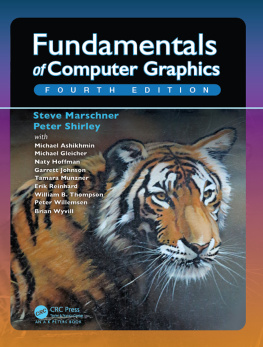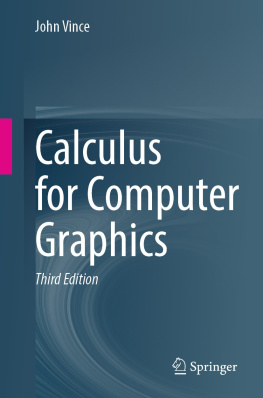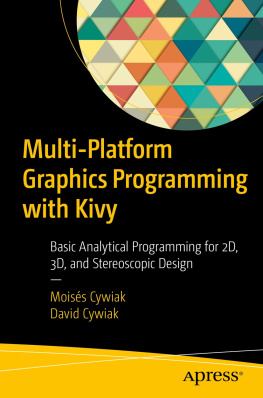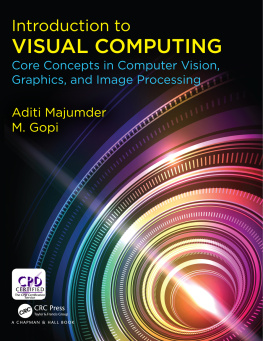Contents
Page List

Fundamentals of Computer Graphics
FOURTH EDITION
Fundamentals of Computer Graphics
FOURTH EDITION
Steve Marschner
Cornell University
Peter Shirley
Purity, LLC
with | Michael Ashikhmin |
Michael Gleicher |
Naty Hoffman |
Garrett Johnson |
Tamara Munzner |
Erik Reinhard |
William B. Thompson |
Peter Willemsen |
Brian Wyvill |

CRC Press
Taylor & Francis Group
6000 Broken Sound Parkway NW, Suite 300
Boca Raton, FL 33487-2742
2016 by Taylor & Francis Group, LLC
CRC Press is an imprint of Taylor & Francis Group, an Informa business
No claim to original U.S. Government works
Printed on acid-free paper
Version Date: 20151012
International Standard Book Number-13: 978-1-4822-2939-4 (Hardback)
This book contains information obtained from authentic and highly regarded sources. Reasonable efforts have been made to publish reliable data and information, but the author and publisher cannot assume responsibility for the validity of all materials or the consequences of their use. The authors and publishers have attempted to trace the copyright holders of all material reproduced in this publication and apologize to copyright holders if permission to publish in this form has not been obtained. If any copyright material has not been acknowledged please write and let us know so we may rectify in any future reprint.
Except as permitted under U.S. Copyright Law, no part of this book may be reprinted, reproduced, transmitted, or utilized in any form by any electronic, mechanical, or other means, now known or hereafter invented, including photocopying, microfilming, and recording, or in any information storage or retrieval system, without written permission from the publishers.
For permission to photocopy or use material electronically from this work, please access www.copyright.com (http://www.copyright.com/) or contact the Copyright Clearance Center, Inc. (CCC), 222 Rosewood Drive, Danvers, MA 01923, 978-750-8400. CCC is a not-for-profit organization that provides licenses and registration for a variety of users. For organizations that have been granted a photocopy license by the CCC, a separate system of payment has been arranged.
Trademark Notice: Product or corporate names may be trademarks or registered trademarks, and are used only for identification and explanation without intent to infringe.
Library of Congress Cataloging-in-Publication Data
Names: Shirley, Peter, 1963- | Marschner, Steve.
Title: Fundamentals of computer graphics / Steve Marschner, Cornell University, Peter Shirley, Purity, LLC ; with Michael Ashikhmin, Michael Gleicher, Naty Hoffman, Garrett Johnson, Tamara Munzner, Erik Reinhard, William B. Thompson, Peter Willemsen, Brian Wyvill.
Description: Fourth edition. | Boca Raton : CRC Press, Taylor & Francis Group, [2016] | Includes bibliographical references and index.
Identifiers: LCCN 2015017094 | ISBN 9781482229394 (alk. paper)
Subjects: LCSH: Computer graphics.
Classification: LCC T385 .S434 2016 | DDC 006.6--dc23
LC record available at http://lccn.loc.gov/2015017094
Visit the Taylor & Francis Web site at
http://www.taylorandfrancis.com
and the CRC Press Web site at
http://www.crcpress.com
Contents
This edition of Fundamentals of Computer Graphics includes substantial rewrites of the chapters on textures and graphics hardware, as well as many corrections throughout. The figures are now in color throughout the book.
The organization of the book remains substantially similar to the third edition. In our thinking, is a number of contributed chapters, authored by contributors we have chosen both for their expertise and for their clear way of expressing ideas.
As we have revised this book over the years, we have endeavored to retain the informal, intuitive style of presentation that characterizes the earlier editions, while at the same time improving consistency, precision, and completeness. We hope the reader will find the result is an appealing platform for a variety of courses in computer graphics.
About the Cover
The cover image is from Tiger in the Water by J. W. Baker (brushed and air-brushed acrylic on canvas, 16 by 20, www.jwbart.com).
The subject of a tiger is a reference to a wonderful talk given by Alain Fournier (19432000) at a workshop at Cornell University in 1998. His talk was an evocative verbal description of the movements of a tiger. He summarized his point:
Even though modelling and rendering in computer graphics have been improved tremendously in the past 35 years, we are still not at the point where we can model automatically a tiger swimming in the river in all its glorious details. By automatically I mean in a way that does not need careful manual tweaking by an artist/expert.
The bad news is that we have still a long way to go.
The good news is that we have still a long way to go.
Online Resources
The website for this book is http://www.cs.cornell.edu/srm/fcg4/. We will continue to maintain a list of errata and links to courses that use the book, as well as teaching materials that match the books style. Most of the figures in this book are in Adobe Illustrator format, and we would be happy to convert specific figures into portable formats on request. Please feel free to contact us at shirley@cs.utah.edu or srm@cs.cornell.edu.
Acknowledgments
The following people have provided helpful information, comments, or feedback about the various editions of this book: Ahmet Oguz Akyz, Josh Andersen, Zeferino Andrade, Kavita Bala, Adam Berger, Adeel Bhutta, Solomon Boulos, Stephen Chenney, Michael Coblenz, Greg Coombe, Frederic Cremer, Brian Curtin, Dave Edwards, Jonathon Evans, Karen Feinauer, Amy Gooch, Eungyoung Han, Chuck Hansen, Andy Hanson, Razen Al Harbi, Dave Hart, John Hart, John Spike Hughes, Helen Hu, Vicki Interrante, Wenzel Jakob, Doug James, Henrik Wann Jensen, Shi Jin, Mark Johnson, Ray Jones, Revant Kapoor, Kristin Kerr, Erum Arif Khan, Mark Kilgard, Dylan Lacewell, Mathias Lang, Philippe Laval, Marc Levoy, Howard Lo, Joann Luu, Ron Metoyer, Keith Morley, Eric Mortensen, Koji Nakamaru, Micah Neilson, Blake Nelson, Michael Nikelsky, James OBrien, Steve Parker, Sumanta Pattanaik, Matt Pharr, Peter Poulos, Shaun Ramsey, Rich Riesenfeld, Nate Robins, Nan Schaller, Chris Schryvers, Tom Sederberg, Richard Sharp, Sarah Shirley, Peter-Pike Sloan, Hannah Story, Tony Tahbaz, Jan-Phillip Tiesel, Bruce Walter, Alex Williams, Amy Williams, Chris Wyman, and Kate Zebrose.
Ching-Kuang Shene and David Solomon allowed us to borrow their examples. Henrik Wann Jensen, Eric Levin, Matt Pharr, and Jason Waltman generously provided images. Brandon Mansfield helped improve the discussion of hierarchical bounding volumes for ray tracing. Philip Greenspun (www.philip.greenspun.com) kindly allowed us to use his photographs. John Spike Hughes helped improve the discussion of sampling theory. Wenzel Jakobs Mitsuba renderer was invaluable in creating many figures. We are extremely thankful to J. W. Baker for helping create the cover Pete envisioned. In addition to being a talented artist, he was a great pleasure to work with personally.












